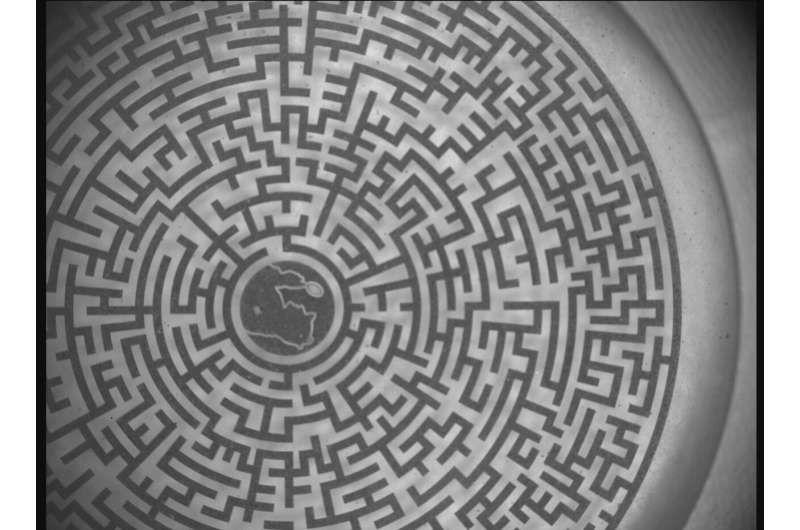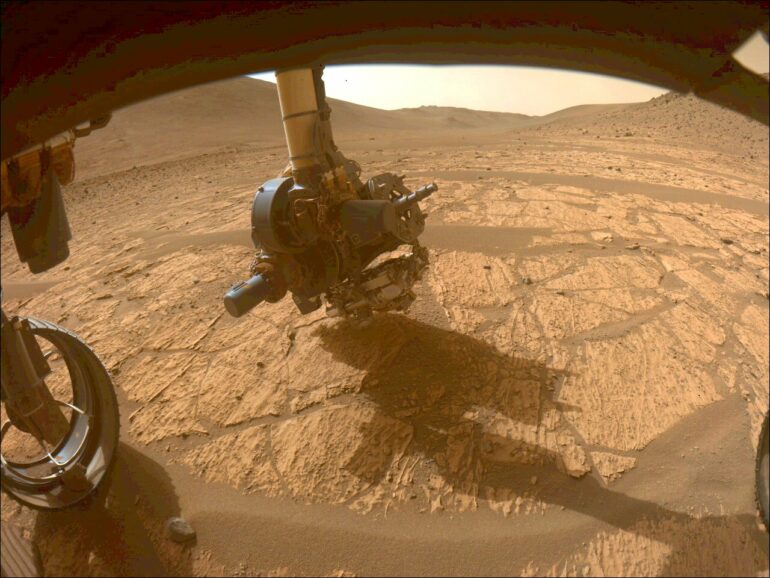After six months of effort, an instrument that helps the Mars rover look for potential signs of ancient microbial life has come back online.
The SHERLOC (Scanning Habitable Environments with Raman & Luminescence for Organics and Chemicals) instrument aboard NASA’s Perseverance Mars rover has analyzed a rock target with its spectrometer and camera for the first time since encountering an issue this past January. The instrument plays a key role in the mission’s search for signs of ancient microbial life on Mars. Engineers at NASA’s Jet Propulsion Laboratory in Southern California confirmed on June 17 that the instrument succeeded in collecting data.
“Six months of running diagnostics, testing, imagery and data analysis, troubleshooting, and retesting couldn’t come with a better conclusion,” said SHERLOC principal investigator Kevin Hand of JPL.
Mounted on the rover’s robotic arm, SHERLOC uses two cameras and a laser spectrometer to search for organic compounds and minerals in rocks that have been altered in watery environments and may reveal signs of past microbial life. On Jan. 6, a movable lens cover designed to protect the instrument’s spectrometer and one of its cameras from dust became frozen in a position that prevented SHERLOC from collecting data.
Analysis by the SHERLOC team pointed to the malfunction of a small motor responsible for moving the protective lens cover as well as adjusting the focus for the spectrometer and the Autofocus and Context Imager (ACI) camera. By testing potential solutions on a duplicate SHERLOC instrument at JPL, the team began a long, meticulous evaluation process to see whether and how the lens cover might be moved into the open position.
SHERLOC sleuthing
Among many other steps taken, the team tried heating the lens cover’s small motor, commanding the rover’s robotic arm to rotate the SHERLOC instrument under different orientations with supporting Mastcam-Z imagery, rocking the mechanism back and forth to loosen any debris potentially jamming the lens cover, and even engaging the rover’s percussive drill to try jostling it loose. On March 3, imagery returned from Perseverance showed that the ACI cover had opened more than 180 degrees, clearing the imager’s field of view and enabling the ACI to be placed near its target.
“With the cover out of the way, a line of sight for the spectrometer and camera was established. We were halfway there,” said Kyle Uckert, SHERLOC deputy principal investigator at JPL. “We still needed a way to focus the instrument on a target. Without focus, SHERLOC images would be blurry and the spectral signal would be weak.”
Like any good ophthalmologist, the team set about figuring out SHERLOC’s prescription. Since they couldn’t adjust the focus of the instrument’s optics, they relied on the rover’s robotic arm to make minute adjustments in the distance between SHERLOC and its target in order to get the best image resolution. SHERLOC was commanded to take pictures of its calibration target so that the team could check the effectiveness of this approach.
“The rover’s robotic arm is amazing. It can be commanded in small, quarter-millimeter steps to help us evaluate SHERLOC’s new focus position, and it can place SHERLOC with high accuracy on a target,” said Uckert. “After testing first on Earth and then on Mars, we figured out the best distance for the robotic arm to place SHERLOC is about 40 millimeters,” or 1.58 inches. “At that distance, the data we collect should be as good as ever.”
Confirmation of that fine positioning of the ACI on a Martian rock target came down on May 20. The verification on June 17 that the spectrometer was also functional checked the team’s last box, confirming that SHERLOC is operational.

Perseverance’s team used the SHERLOC instrument’s Autofocus and Context Imager to capture this image of its calibration target on May 11 to confirm an issue with a stuck lens cover had been resolved. A silhouette of the fictional detective Sherlock Holmes is at the center of the target. © NASA/JPL-Caltech
“Mars is hard, and bringing instruments back from the brink is even harder,” said Perseverance project manager Art Thompson of JPL. “But the team never gave up. With SHERLOC back online, we’re continuing our explorations and sample collection with a full complement of science instruments.”
Perseverance is in the later stages of its fourth science campaign, looking for evidence of carbonate and olivine deposits in the “Margin Unit,” an area along the inside of Jezero Crater’s rim. On Earth, carbonates typically form in the shallows of freshwater or alkaline lakes. It is hypothesized that this also might be the case for the Margin Unit, which formed over 3 billion years ago.
Citation:
Detective work enables Perseverance Mars rover team to revive SHERLOC instrument (2024, June 26)



